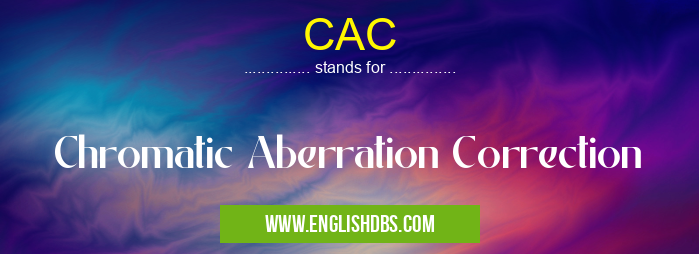What does CAC mean in OPTOMETRY
Chromatic aberration correction (CAC) is a technique used to reduce or eliminate the effects of chromatic aberration in optical systems such as cameras, microscopes, telescopes, and eyeglasses. Chromatic aberration occurs when different wavelengths of light (mainly red, green, and blue) are bent differently as they pass through an optical system. This causes various colors to appear to be out of focus or slightly blurred when viewed from different angles. CAC corrects this problem by precisely adjusting the optical elements to ensure that all wavelengths are equally refracted and focused on the same plane. In this way, CAC can enhance image quality and improve sharpness and color accuracy.

CAC meaning in Optometry in Medical
CAC mostly used in an acronym Optometry in Category Medical that means Chromatic Aberration Correction
Shorthand: CAC,
Full Form: Chromatic Aberration Correction
For more information of "Chromatic Aberration Correction", see the section below.
Essential Questions and Answers on Chromatic Aberration Correction in "MEDICAL»OPTOMETRY"
What is chromatic aberration correction?
Chromatic aberration correction (CAC) is a computer-assisted imaging technology used to reduce or eliminate the presence of various chromatic aberrations present in an image, which can enhance the overall quality of the image. These aberrations are often caused by optical lens imperfections or incorrect settings and can diminish clarity, color accuracy, and sharpness when present in an image. CAC works to restore the clarity, crispness, and vivid colors associated with high-quality imaging.
How does chromatic aberration correction work?
Chromatic aberration correction uses sophisticated algorithms to identify and reduce or remove any color fringes in an image that would otherwise hinder its quality—the most common being purple fringing, red/green fringing, and blue halos. The software corrects for any misalignment between channels as well as any differences in brightness values caused by lens imperfections. This helps ensure that each channel renders the same color more accurately and uniformly throughout the entire image.
What types of images can be corrected using chromatic aberration correction?
Any digital image that contains unwanted chromatic aberrations can benefit from CAC. This includes landscape photography, astrophotography, portrait photography, product photography and many more. Generally speaking, most digital images processed with CAC will result in increased clarity, contrast and realism across all channels.
Are there limits on how much chromatic aberration correction can do?
Yes—CAC cannot completely correct for all types of chromatic aberration present in an image due to its complex nature; however it does a very good job at minimizing it to provide enhanced visual appeal while still maintaining a natural look to your images. In some cases where extreme levels of distortion are present due to lens deficiencies or other factors then manual post-processing may be necessary to further adjust the details.
What are some guidelines when using chromatic aberration correction?
When utilizing this technology it is important to remember that every individual case will be different depending on the distortion present within each specific image. It is recommended that users experiment with various settings within their editing software since different images sometimes require different settings for optimal results. Additionally it is important not to over-correct the desired corrections as this could lead to unnatural looking results.
Are there other methods for correcting chromatic aberrations aside from applying CAC?
Yes—Aside from applying CAC there are other post-processing techniques such as denoising or sharpening which can help reduce distortions caused by chromatic aberrations; however these methods may bring along additional issues such as creating a higher noise level or introducing artifacts into an otherwise clean image so it is advisable to only take one step at a time when adjusting these features.
Does relying solely on automated chromatic aberration correction filter always guarantee optimal results?
While automatic filters offer quick solutions for correcting common forms of distortion they should not be relied upon exclusively as they may leave certain areas unbalanced or introduce other distinct issues into your images which may require additional manual adjustments afterwards. Therefore it’s best practice approach to have several steps involved when dealing with chromatic aberrations.
Does CAC introduce any noticeable artifacts into my imagery after being applied?
Generally speaking CAC has been designed specifically minimize distortions while simultaneously preserving natural detail within ever photograph; however this doesn’t mean artifacts won't appear if too much processing is done or if incompatible settings are used unintentionally while post-processing your images.
Final Words:
Chromatic aberration correction (CAC) is an important tool utilized in today’s high-resolution imaging applications allowing for capturing lifelike pictures even under challenging lighting conditions like underwater or low-light environments wherein accurately pinpointing desired target objects become difficult due to multi-channel interference caused by chromatic aberrations which often lead to washed-out images lacking true clarity & definition. Utilization of CAC techniques can help reduce these instances by providing precise adjustment capabilities making certain that all incoming waveforms remain properly arranged onto a single focused planar platform eliminating any discrepancies stemming from scattering impact resulting from angular separation along merged RGB channels which might otherwise interfere with essential detail presentation ratio & saturation consistent with user expectations leading towards far better results than otherwise possible.
CAC also stands for: |
|
| All stands for CAC |
